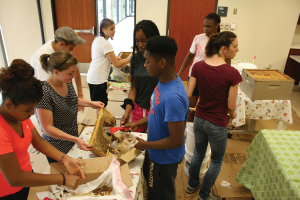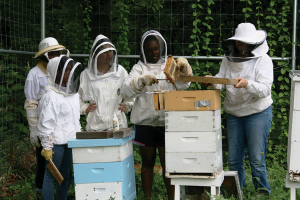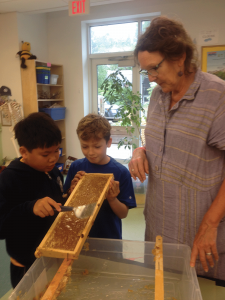
Find me online!
www.twitter.com/tonibee
http://www.citybees.blogspot.com
Connecting Kids and Bees
by- Toni Burnham
Do you remember the first time you stuck your finger into the golden stream of honey produced by your own bees, trickling out of a (probably) hand-cranked extractor, most likely in the company of a more experienced beekeeper who showed you how to select frames, uncap them, and spin out your harvest? For me, it connected the dots, from flowers blooming and jockeying for pollination services all over town (some with bodacious olfactory advertising, some with prolific nectar production, some with the perfect color and bloom configuration) through the health of the colonies I had been hovering over for almost a year and a half, to the people who were about to be gobsmacked by the extraordinary beauty of how Washington, DC tastes when curated by local bees.
We hold community harvests for our beekeepers (especially first harvest experiences) once or twice a year to give them access to tools and to training on how to extract. Over the past few years, however, we have discovered the power of showing non-beeks how to bring home the gold, and to connect the dots between city living and the green world.
How to Make Honey Flow for Non-Beeks
Non-beekeeper honey harvests have taken a couple of forms, roughly: 1) educational settings; and 2) community-building fundraisers, but there is no reason this kind of tool could not be used for other goals. Here’s a short discussion of how and why we do it in educational settings, to be followed next month by advice for engaging entire adult community groups. Hopefully both will offer some lessons learned that might help you to share the power of the harvest with your neighbors who don’t keep bees.
Though it is not strictly part of the harvest, when possible it is most powerful to give participants a chance to visit the beeyard first, though these session descriptions assume that the beekeeper leaders have already pulled frames appropriate for extraction in advance. In small groups with high school age or older participants, where you have legal releases and enough protective gear, you could consider having them help pull a honey super (and put it back after). But don’t try to pull all the honey necessary to engage all participants for an entire event: no one will ever get home!
Whether your group is kids or seniors, be prepared to start with a short – meaning really brief, not more than five to 10 minutes – spiel that explains what honey is, how and when it is produced in your area (name the plants and tell folks where they might see them!), and why it’s all a sideline to the main gig: pollination, and the way the bees connect the plant world to the animal world, and to you and me.
Honey for education
We hold harvests in educational settings for two student populations: elementary school kids (usually between the second and fifth grades) who participate in pollinator and STEM education programs, and high school age members of the “Green Ambassador” Program of the Washington Youth Garden. In each of these settings, we make sure that participants take some part of the harvest home in order to bring the lesson there (if you hook the kids, you probably get the family as a bonus). At two sites, a significant part of the harvest is sold via the PTA or school garden program to finance the programs which invite in the bees. By the way, this reaches additional hundreds of community members who become accustomed to hearing about bees, children, and their neighborhood in the same sentence without freaking out.
If you reckon that we are letting go of a whole lot of honey, that’s pretty much correct, except in the cases where our early harvests promoted the establishment of in on-site hives that now contribute the majority of the honey that reaches the community. At Janney and Horace Mann Elementary Schools in DC, they harvest mostly from their own bees. At the Washington Youth Garden, we started with their own hives. Every single student walks to school through gardens (vegetable and flower) where they see bees, native and other, pollinating, and they see the results of this observed science in their own classrooms and homes later. And they become vocal advocates for honey bee health!

We used cardboard boxes for uncapping tanks bec I forgot a couple of the small ones I usually bring!
Harvesting with school kids
To work in a school-based setting, there is no way to go but through the educators who work there every day. Many beekeepers fear working with young kids because they are unsure how to manage classroom groups. Guess what: you don’t have to. You are there to provide information and an unforgettable opportunity, their teachers are the pros at group dynamics and discipline. They should be there any time you are. Our wonderful and undervalued professional educators can also guide you on the most age-appropriate and relevant content to include, and the side activities you might offer when not everyone can be uncapping or spinning.
Because of our local nectar flow, educational outreach harvests happen late in the school year for classroom programs, and midsummer for garden programs. They need no less than three months advance notice for a first-ever session of this kind: to set up alterations in the school day schedule that allow multiple classes to be present at once or on days when they might not usually meet, and for the instructors to prepare introductory sessions to set up the activities for young students before the actual harvest. This requires time, consultations, and a varying amount of logistics depending on school size, curriculum, and regulations. Sign up your volunteers (I like to have two plus the teachers and any aides available for a whole school day in addition to me) in advance, and provide names to the school so that they are expected. Later years can happen on a far more routine basis.
Managing workflow is the biggest challenge for small ones with short attention spans. It is important to divide classes into manageable chunks, and give sub-groups something to do, with an adult supervisor, in addition to times when they are handling frames or the extractor.
When we work with second- and third-graders (as young as I will go), we provide activity stations: one with veils and (safe) tools, a coloring area with bee-related pages to work on, and sometimes either a mini demo hive with frames they can manipulate or an observation hive manned 100% of the time by a volunteer. Smaller groups require fewer sideshows. If we are going to bother bringing all this stuff and getting this sticky, we usually seek to do a half- or full-day of sessions, with multiple classes rotating through, sometimes two classrooms worth at a time. I like to have two class periods per group (which is why we often end up with a double class size for each session).
With elementary school kids, we use six to eight uncapping forks and three to four uncapping tanks (I make small versions of these out of commercially available plastic bins – about the size of kitty litter boxes – with one or two spare top bars from frames fastened across). There is at least one adult for every two tanks, more if you can recruit them. You can put four kids at each tank: two pairs of students where one holds a frame while the other uncaps one side (or a portion of one side) then they switch and the second member of the pair gets to uncap. For each group of four, demonstrate how to insert and lift the fork a couple of times, and tell them that the less they dig in, the easier it will be for the bees to re-use the wax and make more honey for next year. If you have each kid uncap one half of one side, you only have to bring one frame of honey for every four kids in order to give each a go at it. Some students may not want to, as well.
Everyone is told up front that the forks are sharp, stabbing their partner is not cool, and failure to take this in results in immediate ejection. I’ve never had a kid disrespect this information.
When enough frames are uncapped for your extractor (I like a two- or a four-frame job for this: larger extractors require too many kids to wait too long to see them spin), we load it, have the kids form a line, and give each kid a shot at a set number of cranks (I like to say “1-2-3 next!”). If the kids are tall enough, you can show them how to load. When we get to the end of the cranking queue, if the frames need a couple of adult sized spins, they get it from us. For most of our extractors, the frames need to be turned around and we give the kids a chance to do that, too.
We open the extractors, let the honey flow through that familiar two-piece steel filter set, and proceed to bottling in three-ounce bears before they leave. A little needs to go a a long way! I often let kids stick in a finger if they 1.) wash their hands first; and 2.) don’t double dip (they police each other pretty rigorously on this!) I ask the schools to procure the bears, because they have a better idea of how many kids will be present, and just . . . well . . . because. Over time, I have come to believe that no investment often equals no lasting impression. And hey, we brought the honey!
Sometimes I bring two filter sets and bottling buckets so we can get started before all the frames are extracted (we switch out the first one when there are a few inches in it). It is not critical to get all the honey bottled, but it is helpful to try to send each kid home with some honey the same day (or the next) while the memory and enthusiasm is fresh. The kids really do talk about this with all kinds of enthusiasm for days!
Not all schools are set up to help you do this (sinks in classrooms, etc.) but it is fair to ask for help in gathering up cappings, washing tools and tanks, and loading vehicles with all the stuff you brought. Teachers may have no clue that these activities need to take place, and they should be mentioned from the earliest planning stages to make sure that you have things like helping hands in the hour after school finishes and a place to pull up a car.
Once the kids are all set, it is time to follow through on whatever plan you made with the school for the rest of the honey. Do you get to take it home? Do they keep it, and if so what kind of containers do they need to have and how many? One of our schools sells the honey at a farm stand they run once a week in the school veggie garden, one of our schools makes attractive jars (one of the kids drew the bee on the label, and they all voted on what to call the product) and sold them in an online auction. Other options include sales at annual STEM or Science Fairs, sending flyers home in backpacks, or adding honey sales to an existing PTA program. I ask, and feel entitled to know, whether the proceeds will in any way benefit the type of education me and my volunteer buddies came to provide, and make future choices accordingly.
Kids from junior high onwards
For older kids, like the Green Ambassadors mentioned earlier, sessions are less likely to occur in a classroom and side shows are not likely to be as necessary (though one should never underestimate the power of an obs hive). Go ahead and use the suggestions from above, but realize that you are less likely to be coordinating with a professional educator, content requirements are probably less defined, and you are likely to be providing more of the structure for the session. On the upside, the kids are able to help you with that.
We see these groups in Summer programs/camps, 4H, and community garden contexts. You can give teens some of the responsibilities you might ask of the elementary teachers above, like helping you set up and clean up. However, the context of beekeeping in pollination and environmental stewardship deserves a higher profile from the start, and the program may not have discussed this previously. Having a couple of experienced beekeepers on hand to answer questions and share experiences is important and is more than conversation: it is connection. When I walk into a group of teens from a different part of town, who are less than half my age, I often wonder why they listen to me at all: but I am a lovestruck geek for bees, and when I bring it, they meet me.
These groups are almost always much smaller than the school classes, and I like to show them how the process works, then ask them to organize the work themselves with our supervision and initial demonstration of each task. We ask them to come up with questions about both the harvest and about bees throughout and during the work, and they really do go for important topics that we just don’t cover with little kids, like how bee mating really happens, how the queen can store semen for years, how pesticides may impact drone viability, and how honey and wintering behavior have made honey bees our only true insect partner, even though the honey is the least important gift they give to us.
Like the elementary school kids, this is a “many hands make light work” situation, so we go for uncapping forks rather than hot knives, hand cranked two to four frame extractors rather than large or powered models. Everyone still needs to see that it is not necessary to dig into a frame, but this group is also ready to learn more about how wax requires eight times the nectar resources by weight than honey does, and how their extra care can help a hive sock away more honey and survive more hardily in the Winter ahead.
Whether or not you end up taking home the honey these groups harvest varies a lot, and you need to ask about expectations. For a camp or a 4H seminar, these kids may be part of a weeks-long program, rather than experiencing the harvest as part of a multi-year educational process. There may be no permanent organization with which you will work to market or promote the honey, and the teens may not be around to talk up the experience to the next group to come through (in schools, the second grade is often very aware of what the third grade got to do, and wants in, BAD).
So talk about the unique needs of each young adult program, and how the honey can be used to build bees into future offerings. It is perfectly OK to leave some on the table, but take much home. Even with these limitations, these kids often change the definition of “cool” among their peers to include bees, and the education you give is perfectly timed to influence coursework they may consider during and after high school. This is a way to make science one heartfelt subject.
Honey harvest programs are one of the few ways that we can “do bees” with kids and have them take home both the experience and a product of their hands. If we connect the dots, they don’t look at flowers or the neighborhood around them in the same way. With any luck, this added perspective may create a hopeful future for our bees.
Toni Burnham keeps her bees and helps educate and mentor local beekeepers in the DC area.











